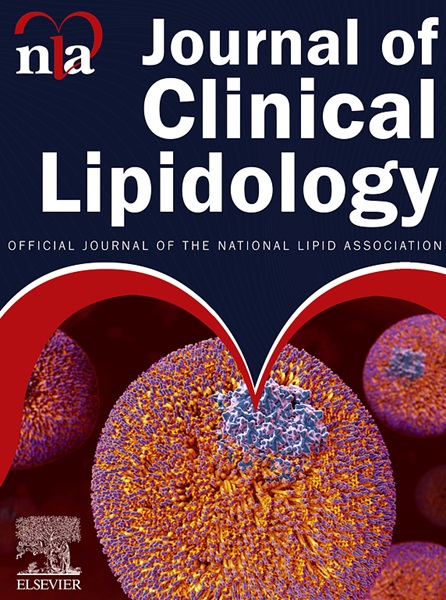当“好”胆固醇出错时:高HDL-C与美国成年人普遍肌肉减少症的横断面关联。
IF 4.6
3区 医学
Q2 PHARMACOLOGY & PHARMACY
引用次数: 0
摘要
背景:肌肉减少——肌肉质量和功能的逐渐减少——与代谢失调有关。尽管高密度脂蛋白胆固醇(HDL-C)通常具有保护作用,但新出现的数据显示其与不良后果呈“u型”关系。我们研究了HDL-C和肌肉减少症之间的关系,并评估了中性粒细胞与淋巴细胞比率(NLR)和胰岛素抵抗的稳态模型评估(HOMA-IR)的中介作用。方法:我们分析了2011年至2014年国家健康与营养检查调查中2167名成年人(≥20岁)的完整双能x线吸收仪、握力和脂质数据。骨骼肌减少症遵循欧洲老年人骨骼肌减少症工作组2标准。调查加权logistic模型从年龄-性别-种族(模型1)发展到身体质量指数(BMI)(模型2)和完整的社会经济和临床协变量(模型3)。连续处理HDL-C,分为5个波段(70 mg/dL)。偏差校正自举中介通过NLR和HOMA-IR检验间接效应。结果:单因素分析中HDL-C与肌肉减少症呈正相关,但完全校正后相关性消失;BMI的增加使系数降低了23%。HDL-C > 70 mg/dL (n = 327)独立预测肌肉减少症(比值比:1.04 / 1 mg/dL, 95% CI, 1.00-1.08)。较低地层差异不显著。NLR无中介作用。HOMA-IR产生了一个小的,负面的间接影响(结论:HDL-C水平的极度升高与肌肉减少症的风险增加有关,表明潜在的复杂关系。HOMA-IR可能部分介导这种关联,因此需要进一步的机制研究。这些发现强调了在评估和管理肌少症风险时考虑胰岛素抵抗和整体代谢健康的重要性。本文章由计算机程序翻译,如有差异,请以英文原文为准。
When ‘good’ cholesterol goes awry: Cross-sectional association of high HDL-C with prevalent sarcopenia in U.S. adults
BACKGROUND
Sarcopenia—the progressive loss of muscle mass and function—is linked to metabolic dysregulation. Although high-density lipoprotein cholesterol (HDL-C) is usually protective, emerging data suggest a “U-shaped” association with adverse outcomes. We examined the relation between HDL-C and sarcopenia and evaluated mediation by neutrophil-to-lymphocyte ratio (NLR) and homeostasis model assessment of insulin resistance (HOMA-IR).
METHODS
We analyzed 2167 National Health and Nutrition Examination Survey 2011 to 2014 adults (≥20 years) with complete dual-energy X-ray absorptiometry, grip-strength, and lipid data. Sarcopenia followed European Working Group on Sarcopenia in Older People 2 criteria. Survey-weighted logistic models progressed from age-sex-ethnicity (Model 1) to body mass index (BMI) (Model 2) and full socioeconomic and clinical covariates (Model 3). HDL-C was treated continuously and as 5 bands (<40, 40-50, 50-60, 60-70, >70 mg/dL). Bias-corrected bootstrap mediation tested indirect effects via NLR and HOMA-IR.
RESULTS
HDL-C was positively associated with sarcopenia in univariate analysis, but the relation disappeared after full adjustment; adding BMI reduced the coefficient by 23%. HDL-C > 70 mg/dL (n = 327) independently predicted sarcopenia (odds ratio: 1.04 per 1 mg/dL, 95% CI, 1.00-1.08). Lower strata were non-significant. NLR showed no mediation. HOMA-IR exerted a small, negative indirect effect (<1% of total).
CONCLUSION
Extremely elevated HDL-C levels have been associated with an increased risk of sarcopenia, indicating a potentially complex underlying relationship. HOMA-IR may partially mediate this association, highlighting the need for further mechanistic investigations. These findings underscore the importance of considering insulin resistance and overall metabolic health in the assessment and management of sarcopenia risk.
求助全文
通过发布文献求助,成功后即可免费获取论文全文。
去求助
来源期刊
CiteScore
7.00
自引率
6.80%
发文量
209
审稿时长
49 days
期刊介绍:
Because the scope of clinical lipidology is broad, the topics addressed by the Journal are equally diverse. Typical articles explore lipidology as it is practiced in the treatment setting, recent developments in pharmacological research, reports of treatment and trials, case studies, the impact of lifestyle modification, and similar academic material of interest to the practitioner.
Sections of Journal of clinical lipidology will address pioneering studies and the clinicians who conduct them, case studies, ethical standards and conduct, professional guidance such as ATP and NCEP, editorial commentary, letters from readers, National Lipid Association (NLA) news and upcoming event information, as well as abstracts from the NLA annual scientific sessions and the scientific forums held by its chapters, when appropriate.

 求助内容:
求助内容: 应助结果提醒方式:
应助结果提醒方式:


